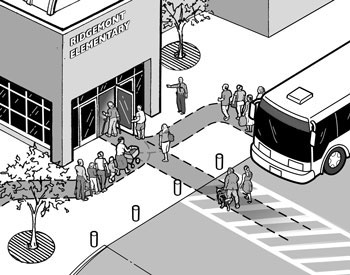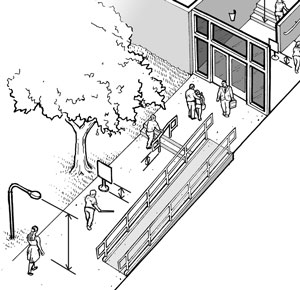Feature 2 - Routes to the Building Entrance
Accessible routes connect accessible onsite features (e.g., bus stop, parking) to the building entrance.
There must be at least one exterior accessible route that connects accessible parking spaces and other accessible elements within the site, such as accessible drop-off areas or a route from a bus stop to an accessible building entrance. The accessible route is essential for people who have difficulty walking or who use wheelchairs or other mobility devices to get to the accessible entrance of the meeting site.
An accessible route is at least 36 inches wide for the entire length of the route. (It may narrow briefly to 32 inches wide at utility poles, post-mounted signs, street furniture, and doorways.) Abrupt level changes, steps, or steeply sloped sidewalks cannot be part of an accessible route. Where ramps are used, they cannot be steeper than 1:12 (8.33% incline). Ramps with a vertical rise of more than 6 inches must have handrails on both sides. Ramps must also have edge protection to stop crutch and walker tips and wheelchair wheels from slipping off the sides, and level landings at the top and bottom of each segment and where a ramp changes direction.
Wherever possible, the accessible route should coincide with the main route to the building. However, if an accessible route is different from the route used by other participants, signs are required at key decision points to direct participants with disabilities to the accessible route to the building.
It is important to note that people who are blind or have low vision may use all routes -- not only the accessible ones -- that lead to a building. Therefore, objects that do not provide sufficient head clearance or that are mounted too high and protrude into a route can become hazards because they cannot be detected by people who are blind or have low vision and use canes. All routes must be free of overhanging objects that are less than 80 inches above the ground. There must also be no objects that protrude more than 4 inches into the route when the bottom edges of the objects are between 27 inches and 80 inches above the ground. Examples of potential protruding objects include handrail extensions on stairs and ramps, post- or wall-mounted signs, outdoor drinking fountains, and low-hanging tree limbs. ADA Standards for Accessible Design (http://www.ada.gov/stdspdf.htm) Accessible routes connect accessible onsite features (e.g., bus stop, parking) to the building entrance.
Common objects along pedestrian routes to the meeting can be hazards to people who are blind or have low vision.



User Comments/Questions
Add Comment/Question